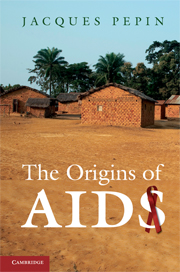Book contents
- Frontmatter
- Contents
- Figures, maps and table
- Acknowledgements
- Abbreviations
- Note on terminology
- Introduction
- 1 Out of Africa
- 2 The source
- 3 The timing
- 4 The cut hunter
- 5 Societies in transition
- 6 The oldest trade
- 7 Injections and the transmission of viruses
- 8 The legacies of colonial medicine I
- 9 The legacies of colonial medicine II
- 10 The other human immunodeficiency viruses
- 11 From the Congo to the Caribbean
- 12 The blood trade
- 13 The globalisation
- 14 Assembling the puzzle
- 15 Epilogue
- References
- Appendix Classification of retroviruses
- Index
7 - Injections and the transmission of viruses
Published online by Cambridge University Press: 05 June 2012
- Frontmatter
- Contents
- Figures, maps and table
- Acknowledgements
- Abbreviations
- Note on terminology
- Introduction
- 1 Out of Africa
- 2 The source
- 3 The timing
- 4 The cut hunter
- 5 Societies in transition
- 6 The oldest trade
- 7 Injections and the transmission of viruses
- 8 The legacies of colonial medicine I
- 9 The legacies of colonial medicine II
- 10 The other human immunodeficiency viruses
- 11 From the Congo to the Caribbean
- 12 The blood trade
- 13 The globalisation
- 14 Assembling the puzzle
- 15 Epilogue
- References
- Appendix Classification of retroviruses
- Index
Summary
Ten years ago, a group of scientists argued that unsterile injections played a role in the emergence of HIV in Africa (and that serial passage of the virus within syringes altered it in a way that made it more virulent and/or more transmissible, something which remains debated among virologists until now). As mentioned in the introduction, after studying this question for some time I came to the conclusion that they were right, that a substantial part of the early amplification of HIV-1 in central Africa occurred through the re-use of improperly sterilised syringes and needles, and that this mechanism was probably as important as the sexual amplification which we just reviewed. It will be impossible to prove this directly. But like a crown prosecutor who has not found the exact gun used in a crime, in the next three chapters we will assemble circumstantial evidence that would ultimately convince any jury. We will first examine how HIV but also HBV and HCV can be transmitted through injections.
Parenteral or iatrogenic
Parenteral is synonymous with injectable; it literally means to bypass the gut, by administering a drug (therapeutic or recreational) or blood product as an injection, either into a vein (IV), muscle (IM), the tissues underneath the skin (SC) or the skin itself (intradermal (ID)). Iatrogenic means during health care; the transmission of pathogens between intravenous drug users is not included in this latter definition, but non-injection modes of healthcare transmission are (for example, during an organ transplant or some other invasive procedure). In sub-Saharan Africa, there is much overlap between these two terms, parenteral and iatrogenic, because the continent has few drug addicts (such a habit is far too expensive) and few patients undergo invasive medical procedures during which a virus could be transmitted.
- Type
- Chapter
- Information
- The Origins of AIDS , pp. 103 - 117Publisher: Cambridge University PressPrint publication year: 2011



